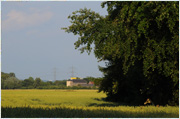How the wetlands were savedback
 Tel: 02173-99986-112
Tel: 02173-99986-112
The landscape of the Urdenbacher Kämpe was shaped by people. Its patchwork of meadow orchards and pastures, fields and fallow is a result of human cultivation. And indeed it was cultivation – carefully adjusted to local requirements – that led to the emergence of a wide range of habitats for many different animal and plant species. Its value as cultivated land also ensured the survival of the Urdenbacher Kämpe as one of the last true flood plains along the River Rhine in the twentieth century. For when Hitler came to power in 1933, the authorities began to think about reviving older plans for dikes and embankments. While ostensibly about flood control, reading between the lines it is clear that the real aim was to implement a grand public works scheme to reduce unemployment. However, the two major landowners in the area, Freiherr von Diergardt and Count Nesselrode, were strictly opposed to the scheme. In letters of increasing acerbity they explained that the recurrent floods were what kept their fields and pastures fertile; that a dike would make the River Rhine between Zons and Baumberg dangerously narrow; that the scheme would bring no benefits, but was destructive and would only cost money. Factual arguments are not always welcome, however, and the authorities were not to be swayed. Count Nesselrode countered with a policy of endless delay. After a serious row in 1934, it was two years before the head of the local government once more approached the count, inviting him to a meeting. It took the count's agent two months to reply with the information that his employer was traveling and not expected to return for another month. With negotiations continuing at this speed, the scheme was finally shelved in 1938, when Nazi Germany started preparing for war.
Photo: Joschka Meiburgback






